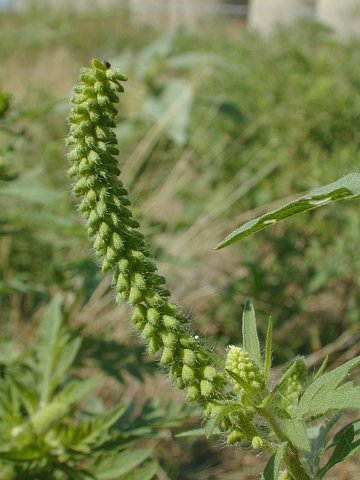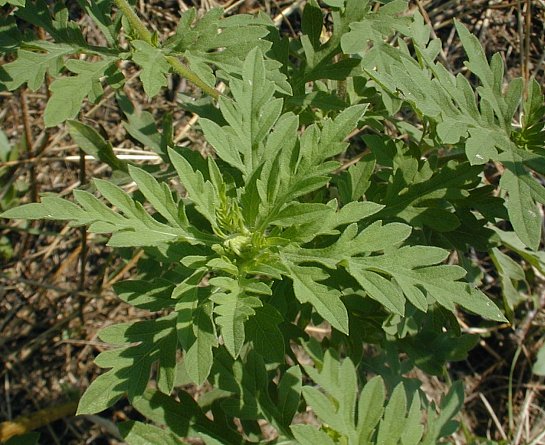Description: This plant is a summer annual up to 3' tall that branches frequently. The hairy stems are green to light pinkish red. The leaves are up to 6" long and 4" across, and are opposite or alternate along the stems. They are deeply pinnatifid, broadly lanceolate (in outline), and usually much wider at the base than the tip. Mature leaves are relatively hairless, but small emergent leaves often have hairs on their undersides. Many of the upper stems terminate in one or more cylindrical spikes of flowers about 1-4" long. Near the base of the central flowering spike, one or two small spikes may develop that are only half as long. The small flowers are initially green, but later turn yellowish green or brown as they mature and develop into achenes. Each flower is about 1/8" long, the males producing a fine yellow pollen that is easily carried by the wind. This pollen is usually released during late summer or early fall. Numerous seeds are produced, which can remain viable for 5 years or more. The extensive root system is fibrous.

Cultivation:
The
preference is full sun and average to slightly dry conditions. This
plant is rather indifferent to soil type, and will thrive in soil
containing high amounts of clay, gravel, or sand – in fact, it prefers
sterile soil because of the reduced competition from other plants.
Resistance to drought is very good, although some of the lower leaves
may wither away. Common Ragweed is often persistent and aggressive
because the seeds can remain viable in the soil for several years. This
common plant will introduce itself into a wildflower garden or native
habitat, whether it is wanted or not.
Range & Habitat:
The native Common Ragweed is very common and widespread, occurring in
every county of
Illinois (see Distribution
Map). It can be found in disturbed areas of upland prairies,
particularly along the margins near developed
areas. Other habitats include weedy meadows, cropland, abandoned
fields, vacant
lots, fence rows, roadsides, gravelly areas along railroads,
gardens and lawns, construction sites, and waste areas. This plant
thrives in a variety of disturbed sunny sites, especially where the
topsoil has been exposed. It has allelopathic
properties that can inhibit the growth and development of neighboring
plants.

Faunal Associations: Common Ragweed (Ambrosia artemisiifolia) is very valuable to many kinds of wildlife. Honeybees have been observed collecting pollen from the male flowers, otherwise flower-visiting insects are not attracted to this plant. Many kinds of insects feed destructively on Common Ragweed. This includes the larvae of long-horned beetles, larvae of weevils, larvae and adults of leaf beetles, larvae of tumbling flower beetles, larvae of leaf-miner flies, plant bugs, Uroleucon ambrosiae (Brown Ambrosia Aphid) and other aphids, Stictocephala bisonia (Buffalo Treehopper) and other treehoppers, mealybugs, larvae of Adaina ambrosiae (Ragweed Plume Moth) and many other moths, and grasshoppers (see Insects Table). Many upland gamebirds and granivorous songbirds are attracted to the oil-rich seeds (see Bird Table). Because the spikes of seeds often remain above snow cover, they are especially valuable to some of these birds during winter. The seeds are also eaten to some extent by the Thirteen-Lined Ground Squirrel, Meadow Vole, and Prairie Vole (Martin et al., 1951/1961). The seeds are probably semi-digestible, thus some of them are likely distributed far and wide by these animals. Because the foliage of Common Ragweed is bitter, it is usually avoided by most mammalian herbivores, although Elk and the Domesticated Goat are known to feed on the foliage (Schneider et al., 2006; Blackmore, 1998).

Photographic Location: The photographs were taken in a waste area along a gravel road near Champaign, Illinois.
Comments: Common Ragweed is a major cause of hay fever during the late summer and early autumn. Aside from this unfortunate characteristic, it has considerable ecological value to various birds, moths, and other insects, therefore it isn't necessarily desirable to destroy this plant on sight. Compared to other ragweeds (Ambrosia spp.) that occur in Illinois, Common Ragweed has more deeply pinnatifid leaves.